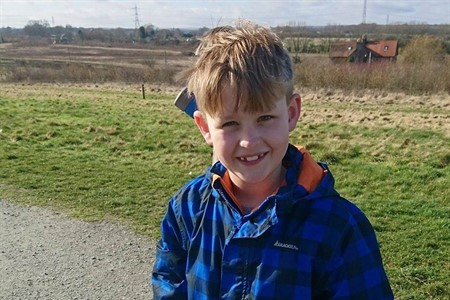
01 August 2017
It’s always great to hear how our LOCband babies are getting on, so it was a lovely surprise to hear from Ewan Reading’s mother, Natalie nine years after he was treated for positional plagiocephaly at the London Orthotic Consultancy. Also known as flat head syndrome, plagiocephaly is a condition where part of a baby’s head becomes flat on one side due to continued pressure on one spot. It’s a common problem, affecting one in every five babies, although it does not cause pain or any other symptoms.
We first saw Ewan back in 2008 at just four months old for helmet therapy treatment, which uses a cranial moulding orthosis or helmet – what we call the LOCband. Each helmet consists of a soft foam layer inside a thermoplastic shell, and is made bespoke for each baby and adjusted to accommodate their natural head growth as treatment continues.
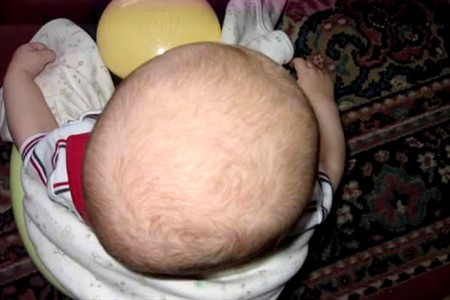
Above: Natalie noticed a flat spot on the back of Ewan's head at 4 months old
“The clinic was welcoming,” Natalie remembers. “Ewan was four months old and I could breastfeed while he was wearing the helmet. At the clinic, they took their time with him. It made a huge difference knowing that we could trust them.”
The helmet treatment is non-invasive and works by applying gentle, constant pressure over the areas of your baby’s skull that are most prominent, allowing unrestricted growth over the flattened areas. This is the most effective treatment as it’s pain-free – the helmet consists of a soft foam layer inside the thermoplastic shell and allows for frequent adjustments during growth. This helps with guiding your baby’s skull into a more symmetrical shape. It does require significant commitment – Ewan needed to wear his helmet for four months every day for 23 hours.
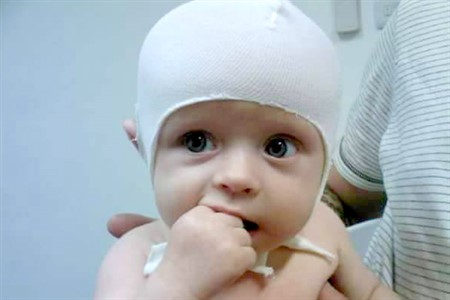
Above: Ewan having his head scanned in an early appointment
However, Natalie says it was not an uncomfortable process for Ewan, “he had treatment throughout the summer and wore the helmet very well, the helmet was easy to manage, putting it on and off was a breeze and Ewan didn’t get irritated by it.”
Helmet therapy helped reduce Ewan’s plagiocephaly from 17mm asymmetry to 5mm. A huge difference, says Natalie, that would not have been possible by relying on repositioning alone. In most cases of plagiocephaly, repositioning is the first place to start, but if a child’s condition is moderate to severe, parents may look for additional help, like helmet therapy.
LOCband treatment is most effective in babies aged between four and seven months and treatment generally lasts between three to six months. Natalie says that Ewan’s early diagnosis not only reduced her worries and uncertainties but also meant more could be done. This is because the younger a baby is, the more malleable their head. Babies up to the age of 14 months can also be treated but it may take longer to correct and results may not be as pronounced. It is possible to treat older babies and we have had success with babies aged up to 24 months, but after the age of two the plates in the head become rigid and helmet therapy will not be able to improve head shape.
Are you concerned about your baby’s head shape? You can use our online flathead diagnosis form for a fast, free and confidential clinical opinion from a fully qualified orthotist.
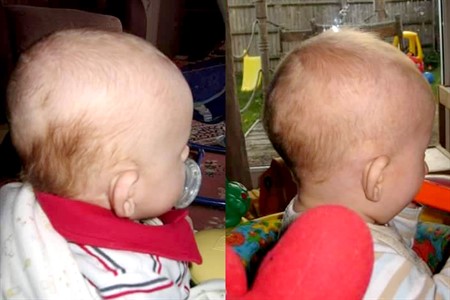
Above: Ewan before and during LOCband treatment
Now aged nine, Natalie says that Ewan is a “confident and happy child, and the helmet therapy was definitely the right decision for us.” Still pleased they decided to go with the helmet therapy, Natalie states “I would (and have) recommended LOC to anyone, the clinic was friendly and reassuring.”
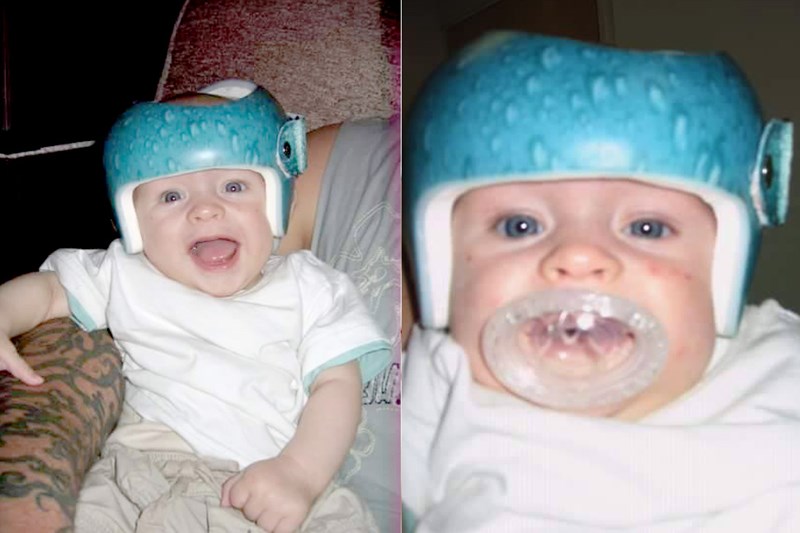
Above: Ewan in his blue bubble LOCband
We firmly believe in the importance of parents sharing their experiences with others, and Natalie has been kind enough to say she would be happy to answer questions or queries from anyone who may be worried or feel anxious about their child having flat head syndrome. You may also like to join our LOCband Facebook community, where parents swap advice, tips and assistance during an often-difficult time.
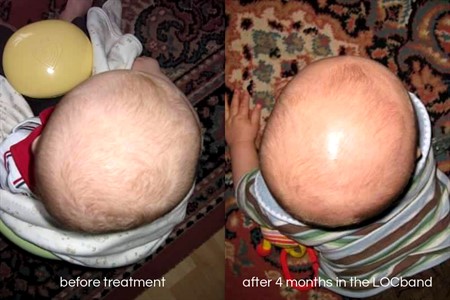
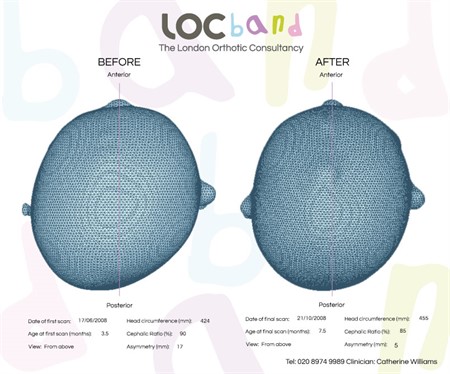
If you’re concerned about the shape of your baby’s head and would like an expert opinion from one of our clinicians, fill out our flat head diagnosis form and upload a few photographs of your baby’s head from different angles. We will respond within 24 hours. Our assessment should establish whether your baby has plagiocephaly although it may not be possible to say how severe it is.
Ewan is now doing well at 9 years old!

This is very much dependent on how fast your baby is growing. The faster the growth, the more frequently your baby will be seen so that the helmet can be adjusted. In general, reviews will happen at two to four-week intervals.
The price of treatment covers:
Yes - All babies that have completed their course of treatment with us have achieved a measurable improvement in head shape. However, you don’t have to take our word for it.
Recent independent research conducted by a University Hospital in Germany has endorsed the treatment for babies with moderate or severe plagiocephaly.
A larger, retrospective study has just been published that found complete correction was achieved in 94.4% of babies treated with helmet therapy.
The results were conclusive: repositioning achieved acceptable correction in 77.1% of cases, but 15.8% were moved onto helmet therapy because re-positioning was not working. Meanwhile, 94.4% of the infants who started in the helmet-treated group achieved full correction, as did 96.1% of those who were transferred from the repositioning group into the helmet-treated group.
Further information can be found on our Plagiocephaly Research page.
If your baby has a temperature or a fever due to illness you must remove the band. The band can be put back on once the temperature has returned to normal.
The optimum age for treatment is between four and seven months.
This is because the skull is most malleable at this age and improvements to head shape tend to take less time and are more dramatic. That is not to say that helmet therapy should be ruled out if the baby is older than seven months. Routinely, babies up to the age of 16 months can be treated very successfully.
The cut off age is around 18 months when the fontanelles (soft spots on the head) are no longer malleable. As babies grow and develop at different rates, it is always worth checking if you are not sure. There have been cases where a baby’s fontanelles have not fused yet by the age of 18 months, who have achieved successful, but less-marked results with cranial remoulding therapy.
Torticollis is a condition in which a tight or shortened muscle in one side of the neck causes the head to tilt or turn to one side, resulting in the infant resting its head in the same position. In 2013, we analysed the data from all first appointments in our Kingston clinic and found that 20% of the babies examined had some kind of neck condition that was causing head immobility.
The clinics and clinicians that provide this treatment in the UK will have received similar training and experience. However, we are the only clinic that manufactures its own helmet and our clinicians are closely involved with the process for each individual helmet that we produce.
In addition, we do not restrict review appointments to a set number, we are extremely flexible and respond to individual parents' needs so that the best outcome can be achieved for each baby.
The LOCband is non-invasive and works by applying gentle, constant pressure over the areas of the baby’s skull that are most prominent while allowing unrestricted growth over the flattened areas. The band consists of a soft foam layer inside a thermoplastic shell. As the baby grows, the band will be adjusted frequently to gently guide the skull into a more symmetrical shape.